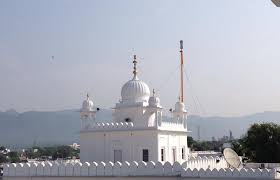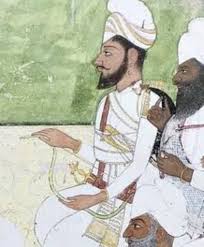DAL SINGH, BHAI (1885-1921), one of the Nankana Sahib martyrs, was born on 8 Assu 1942 Bk / 23 September 1885, the son of Bhai Musadda Singh and Mat Gulabi, a Kamboj couple of Nizampur village in Amritsar district. The family later migrated to Chakk No. 38 Nizampur Deva Singhvala in the newly developed canal district of Sheikhupura, now in Pakistan. Dal Singh remained illiterate, but had committed to memory several of the religious and historical compositions.
DAYA SINGH, BHAI (1661-1708), one of the Panj Piare or the Five Beloved celebrated in the Sikh tradition, was the son of Bhai Suddha, a Sobti Khatri of Lahore, and Mai Diali. His original name was Daya Ram. Bhai Suddha was a devout Sikh of Guru Tegh Bahadur and had visited Anandpur more than once to seek his blessing. In 1677, he travelled to Anandpur along with his family including his young son, Daya Ram, to make obeisance to Guru Gobind Singh, this time to settle there permanently. Daya Ram, already well versed in Punjabi and Persian, engaged himself in the study of classics and gurbani. He also received training in the use of weapons.
DHARAM SINGH, a Jatt Sikh of the village of Chitti, 15 km southwest of Jalandhar in the Punjab, was one of the associates of Bhai Maharaj Singh (d. 1856), leader of anti British revolt in the Punjab during 1848-49. Dharam Singh assisted Bhai Maharaj Singh by mobilizing help for him in the Doaba region during the latter half of 1849. He especially introduced two artillerymen of Kapurthala to Bhai Maharaj Singh, in Hoshiarpur area. He was arrested along with Maharaj Singh on the night of 28-29 December 1849, but managed to escape. However, he was rearrested at Wazirabad in Gujranwala district and was held in custody in Lahore jail.
DHILVAN KALAN, village 5 km southeast of Kot Kapura (30° 35`N, 74° 49`E) in Faridkot district of the Punjab, was the abode of Sodhi Kaul, shortened from Kaulnain, a descendant of Guru Arjan`s elder brother, Prithi Chand, and thus a collateral relation of Guru Gobind Singh. According to Bhai Santokh Singh, Sri" Gur Pratap Suraj Granth, Guru Gobind Singh, displeased at Chaudhari Kapura`s refusal to assist him in warding off the pursuing army from Sirhind, left Kot Kapura and came to Dhilvari Kalari, where Sodhi Kaul and his four sons received him with honour.
DOD. village 13 km northeast of Jaito (30° 26`N, 74° 53`E) in Faridkof district of the Punjab, is sacred to Guru Gobind Singh. who visited here during his journey westward from Dina in December 1705. According to local tradition, Guru Hargobind had also been here during his travels through the Malva country. Gurdwara Dhaulsar Patshahi Chehmi te Dasmi on the northwestern outskirts of the village is dedicated to Guru Hargobind and Guru Gobind Singh. It comprises a flatroofed hall with a verandah on three sides.
DUNI CHAND, grandson of the well known Bhai Salho (d. 1628), a Dhalival Jatt of Majitha in Amritsar district in the Punjab, was a masand of the Guru`s nominee in the Majha area. A hefty man of immense bulk, Duni Chand led out a band of 500 warriors to Anandpur in 1700 when the Rajput hill chiefs had laid siege to the town. One day it was reported to Guru Gobind Singh that the besiegers were planning to use a drugged elephant the following morning to force open the gate of the Lohgarh Fort. To quote Kuir Singh, Gur Bilas Patshahi X, the Guru said, "I too have an intoxicated elephant, Duni Chand.








